Discover Gunung Kawi Temple, a historical gem in Tampaksiring, Bali, known as ‘The Valley of the Kings’. This temple dates back to the 11th century and is a cornerstone of Bali’s spiritual and artistic heritage. Furthermore, the complex features ten mystical rock-carved ‘candi’, each reflecting a blend of mysticism and the island’s royal history. As a vibrant symbol of Balinese spirituality, Gunung Kawi offers visitors a unique insight into the island’s ancient culture and traditions. Meanwhile, this guide will help you navigate this sacred site, revealing its historical significance and providing practical tips for your visit.
Table of Contents[Hide][Show]
Gunung Kawi Temple’s Historical and Cultural Significance
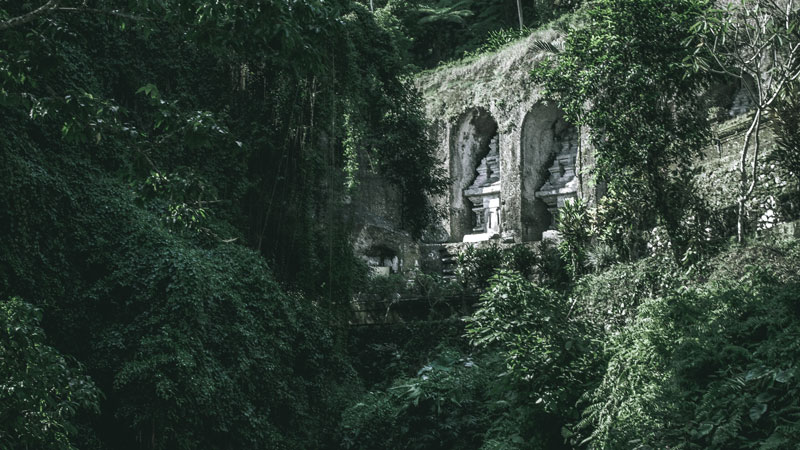
Above all, Gunung Kawi Temple, set amidst Bali’s lush landscapes, is a monument to the island’s storied past and spiritual depth. To explore the rich history of Bali’s temples further, check out our comprehensive guide to Taman Ayun Temple.
The Royal Legacy of Gunung Kawi Temple Tampak Siring
Subsequently, Gunung Kawi’s history, which spans the 11th century, is deeply intertwined with that of the Udayana dynasty. Furthermore, King Udayana, a notable figure from the Warmadewa Dynasty, and his queen, Gunapriya Dharma Patni, had significant roles in Bali’s history.
Their sons, Erlangga, who later ruled in East Java, and Anak Wungsu, who governed Bali, were instrumental in the temple’s inception. During Anak Wungsu’s reign, the temple, primarily dedicated to this royal lineage, is believed to have been constructed.
Archaeological evidence, including an inscription in Kediri script reading “haji lumahing jalu” (translated as “the king symbolically laid to rest in Jalu”), supports this theory. The term ‘jalu’ is often associated with a keris or Pakerisan, linking the temple to the Pakerisan River that divides it.
Gunung Kawi’s Folklore and Construction Legends
In addition to its historical roots, local folklore adds a mystical layer to Gunung Kawi’s origin. A popular tale credits the temple’s construction to Kebo Iwa, a legendary figure endowed with supernatural strength.
According to this story, Kebo Iwa carved the temple’s intricate candi into the cliff face using his sharp nails, completing this monumental task in a day, a feat that would have taken many people much longer.
Architectural Marvels of Gunung Kawi’s Ten Shrines
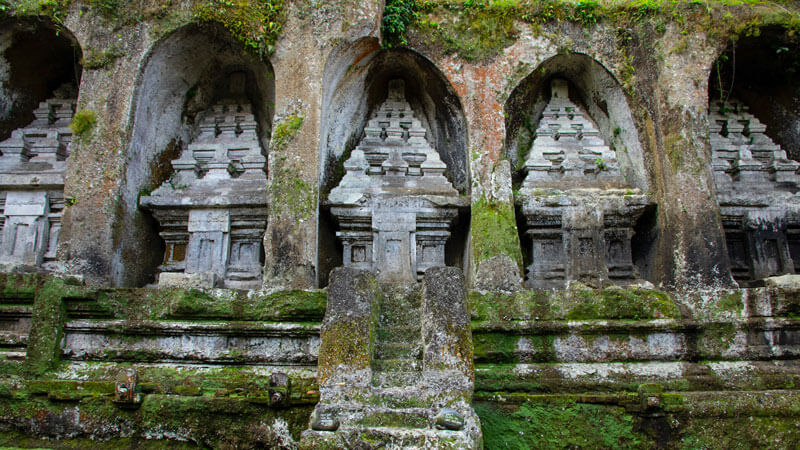
The temple features ten rock-cut candi (shrines), each about 7 meters high and majestically carved into the cliff face. These shrines, which represent cenotaphs rather than actual burial sites, honor the Udayana dynasty.
In particular, their intricate carvings and architectural brilliance are a testament to the skills of ancient Balinese artisans, encapsulating a narrative carved into the island’s cultural heritage.
Upcoming Section: Next, we’ll provide practical tips for visiting Gunung Kawi, ensuring a fulfilling and well-informed travel experience.
Preparing for Your Visit to Gunung Kawi Temple Tampak Siring
Prepare for an enriching visit to Gunung Kawi Temple, a significant historical site in Bali’s Tampaksiring area.
Accessing Gunung Kawi Temple: Location and Directions
- Address: Jl. Pejeng, Tampak Siring, northeast of Ubud. Find Gunung Kawi Temple’s location on Google Maps.
- Reaching Gunung Kawi from Ubud: Nestled 14km northeast of central Ubud, Tampaksiring is not just a location but a journey into Bali’s heart. The adventure to Gunung Kawi is enriching for those who ride a motorbike.
Options for Getting There:
- Taxi/Private Car: Ideal for those seeking comfort and ease.
- Guided Tour: An enriching way to experience Gunung Kawi, complete with narratives and historical contexts.
Scooter Rental for Gunung Kawi Exploration
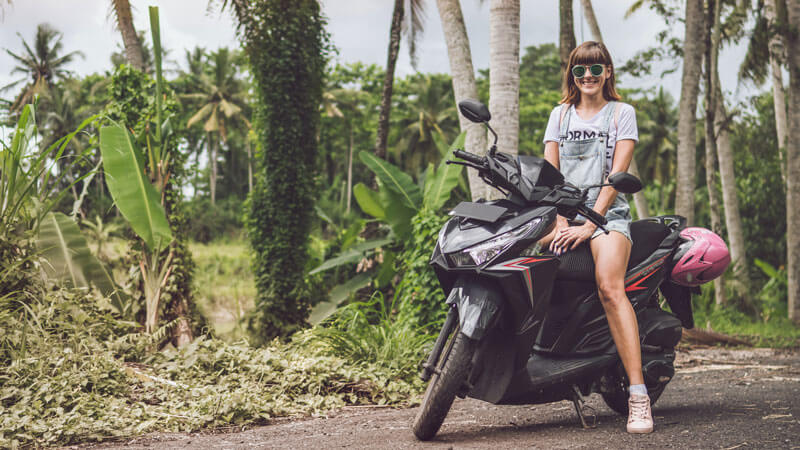
Consider renting a scooter for a flexible and adventurous trip to Gunung Kawi. Scooter rental is a popular choice for the free-spirited, with rentals typically ranging from IDR 100,000 to IDR 250,000 for 24 hours (excluding fuel). Arranging it in advance ensures availability and convenience. Scooter rental typically includes:
- Helmets for safety
- A mobile phone holder for navigation ease
- A full tank of fuel for immediate travel.
In other words, scooter travel offers a unique way to experience Bali’s landscapes intimately, making your journey to Gunung Kawi as memorable as the destination. For more insights on traveling around Bali, explore our detailed guide on local transportation.
Best Times to Explore Gunung Kawi Temple
- Best Times to Visit are early morning for tranquility or late afternoon for a serene atmosphere. Each provides unique lighting and ambiance.
Discover the best times to visit Bali for vacation in our article.
Gunung Kawi Temple Entrance Fee
| Category | Visitor Type | Entrance Fee |
|---|---|---|
| Adult | Domestic | Rp 50,000 |
| Adult | International | Rp 75,000 |
| Child (5-11 years old) | Domestic | Rp 25,000 |
| Child (5-11 years old) | International | Rp 50,000 |
| Child (Under 5 years old) | All Visitors | Free |
Opening Hours and Average Visit Duration
| Detail | Information |
|---|---|
| Operating Hours | 07:00 – 18:00 daily |
| Average Visit Duration | 1.5 hours |
Important Note:
- The entrance ticket price and operating hours of Gunung Kawi Temple, Tampak Siring, are subject to change without prior notice.
- This ticket price information was last updated on January 1, 2025.
- To ensure the latest information, it is recommended to contact the destination management before visiting.
Transportation Tips
- Car Rental: For about IDR 700,000, rent an MPV with a driver and fuel for 12 hours, which is ideal for groups. Learn more about car rentals and rates in our complete guide to car rentals in Bali.
- Scooter Rental: Offers the flexibility to explore more of Ubud and its surroundings.
Plan your visit to Gunung Kawi Temple for a memorable experience that blends Bali’s rich cultural and historical heritage with the beauty of its natural landscapes. For more exciting destinations in Bali, explore our list of the Top 20 Most Popular Places to Visit.
Navigating Through the Rich History of Gunung Kawi
Descending into Gunung Kawi’s Valley: A Journey Through History
Embark on a historical journey as you descend to Gunung Kawi Temple Tampak Siring, with each step revealing Bali’s lush natural beauty and rich heritage.
What to Expect at Gunung Kawi: Terrain and Insights
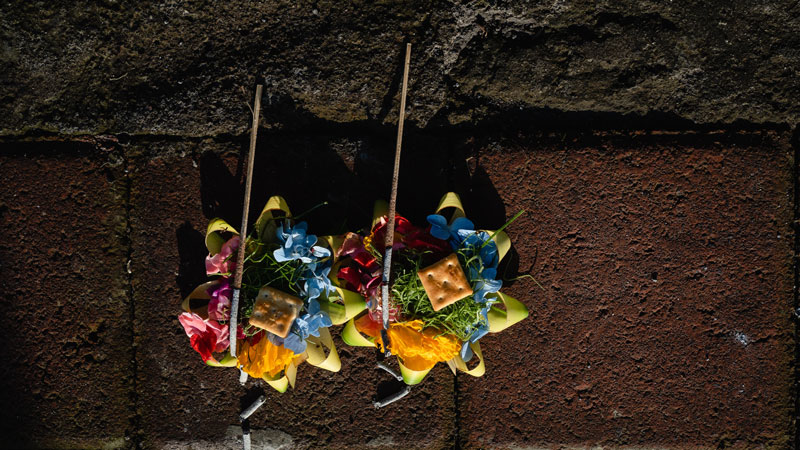
- Path to the Temple: The 1.1 km (0.7 miles) walk from the parking area involves a steep climb. Furthermore, the pathway is paved and equipped with handrails for support.
- Steps and Scenery: Over 270 steps lead to the temple, winding through picturesque settings of terraced rice fields and verdant landscapes. The climb, while scenic, is physically challenging.
- Preparation: Wear comfortable shoes with good traction, carry water for hydration, and use sun protection on warmer days.
- Cultural Insights: Along the way, you will encounter traditional Balinese offerings like canang sari, which will enhance the spiritual atmosphere of your visit.
- Accessibility: The steep and uneven paths may pose challenges for disabled visitors.
- Tranquil Experience: Gunung Kawi is a UNESCO World Heritage Site but often less crowded than other tourist spots. This allows for a peaceful and unhurried visit.
Discover more unique and unusual sights in Bali with our curated list of ten must-visit attractions.
Cultural Etiquette and Dress Code
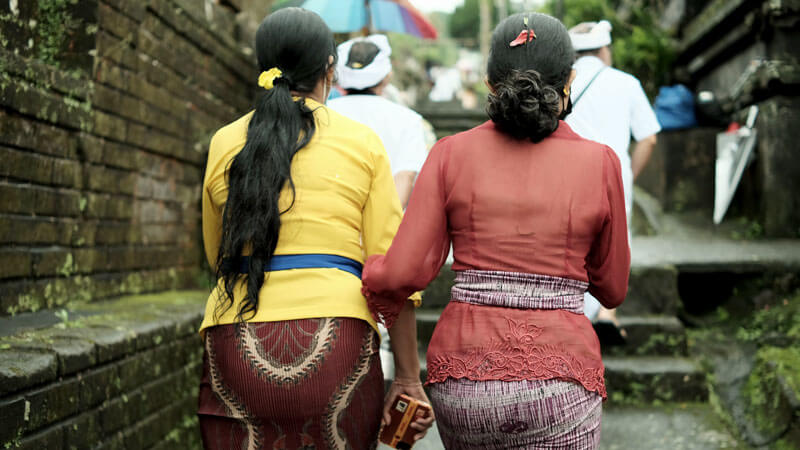
Dressing Appropriately for Gunung Kawi Temple: Cultural Etiquette
- Appropriate Attire: Wear modest clothing covering shoulders and knees, suitable for Bali’s tropical climate. Lightweight and breathable fabrics like cotton are recommended.
- Sarong and Sash: Wearing a sarong and sash at the temple is mandatory. Bringing your own can enhance comfort and expedite entry. If you’re unsure how to wear a sarong, online tutorials or local assistance at your accommodation can help. For visual guidance, watch a video tutorial on wearing a sarong.
- Benefits: Your sarong and sash reflect your style, eliminating the need for rental queues.
Behaviour Guidelines within the Temple
- Conduct: Please behave quietly and gently inside the temple to respect the sanctity of the place and its worshippers.
- Photography: Take photos respectfully without posing in front of shrines or using flash. Always be mindful of restricted areas.
Closing Reflection
Respecting these cultural practices enriches your experience at Gunung Kawi and allows you to appreciate Bali’s spiritual and cultural heritage more deeply. Our guide to Saraswati Temple in Ubud explains the cultural significance of other Balinese temples.
Discovering Nearby Attractions Around Gunung Kawi Temple
Extend your exploration around Gunung Kawi to uncover more of Bali’s cultural and natural treasures. These nearby attractions offer a unique glimpse into the island’s rich heritage.
Tirta Empul Temple: A Stone’s Throw from Gunung Kawi
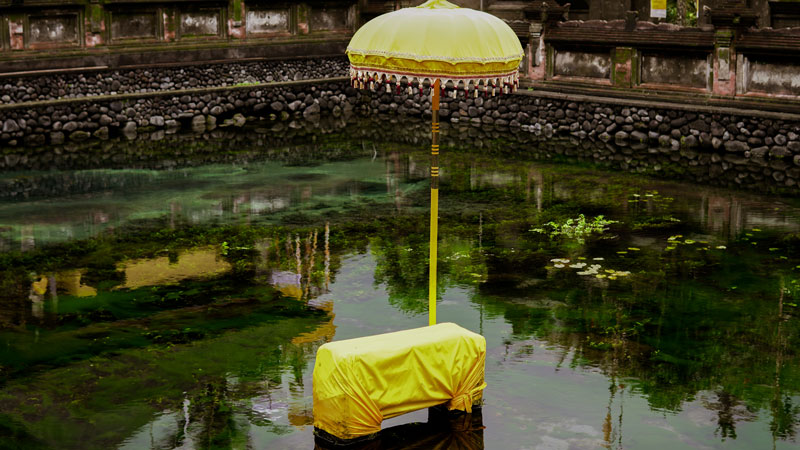
- Location: Just a short drive from Gunung Kawi. Find Tirta Empul Temple on Google Maps.
- Features: Known for its sacred springs and traditional purification rituals. A site of architectural beauty and spiritual significance.
Discover the mystical allure of Tirta Empul Temple, a sanctuary of purification and spiritual serenity, and delve into the sacred rituals that define Bali’s cultural heart.
Tegallalang Rice Terraces
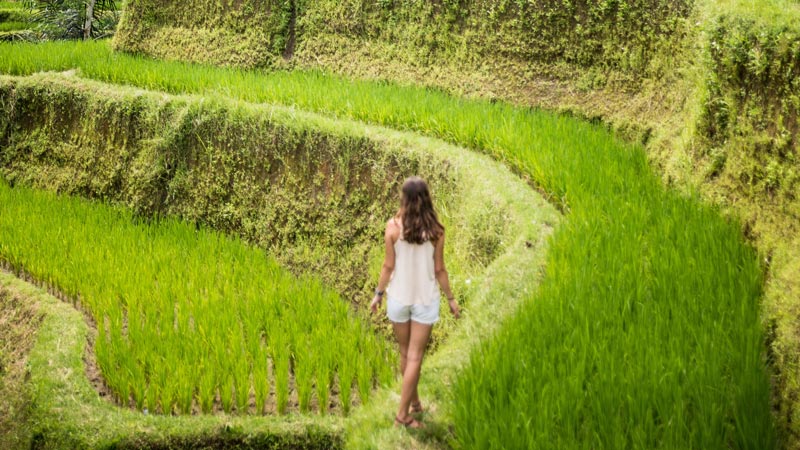
- Location: North of Ubud, a short journey from Gunung Kawi. Find Tegalalang Rice Terrace on Google Maps.
- Features: It is famous for its picturesque terraced rice fields, which showcase Bali’s ‘subak’ irrigation system. These fields are ideal for early morning photography.
Immerse yourself in the breathtaking beauty of Tegalalang Rice Terrace, where Bali’s timeless agricultural artistry unfolds in a stunning tapestry of greenery and innovation.
Goa Gajah (Elephant Cave)
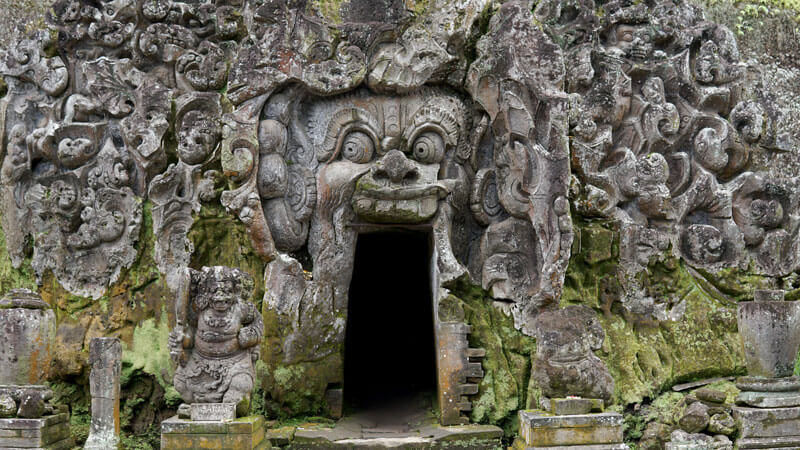
- Location: Near Gunung Kawi. Find Goa Gajah Temple on Google Maps.
- Features: An archaeological site dating back to the 9th century, featuring rock carvings, meditation caves, and bathing pools, offering insights into Bali’s ancient religious practices.
Explore the ancient mystery of Goa Gajah, the Elephant Cave, a historical treasure trove that reveals the depth and richness of Bali’s archaeological wonders.
Furthermore, visiting Tirta Empul, Tegallalang Rice Terraces, Goa Gajah, and Gunung Kawi enriches your Bali experience, blending spiritual exploration with natural beauty and historical discovery.
Explore the historical and cultural depth of Uluwatu Temple with our ultimate guide.
Delving Deeper: Local Insights at Gunung Kawi Temple Tampak Siring
Explore the cultural and historical depths of Gunung Kawi Temple Tampak Siring, where local guides and customs bring the site to life.
The Role of Local Guides
The temple’s tranquility is best appreciated with a guide, as the ruins are explained in limited detail. If available, carry a guidebook or brochure to understand the site’s history better.
As Bagus Perbawa, from Denpasar, Indonesia, highlighted in a TripAdvisor review, the value of local guides at Gunung Kawi cannot be overstated. These guides, often from nearby communities, enrich your visit with stories and insights that aren’t immediately apparent. They interpret temple carvings and architectural details, revealing the deeper layers of Balinese Hinduism.
Engaging in Gunung Kawi’s Local Customs and Ceremonies
At Gunung Kawi, you can witness and participate in local ceremonies and spiritual practices that form the essence of Balinese culture. These events, filled with music, dance, and offerings, glimpse the island’s deep spiritual heritage.
Meditation and Spiritual Practices:
Jro Mangku I Ketut Wirawan, the temple’s caretaker, acknowledges that the temple area is often used for meditation. Visitors may also observe or partake in ‘Melukat’, a purification ritual involving holy water (‘tirta’). This sacred water serves dual purposes: ceremonial offerings (‘acara) and personal spiritual practices.
Ceremonial Timings:
The temple celebrates its main festival, Piodalan, on the ‘Purnama Katiga’ (the third full moon), which lasts four days. Elaborate rituals and a heightened spiritual atmosphere mark this period.
During your visit, approach these customs with respect and curiosity. Dress appropriately, maintain a respectful distance, and adhere to photography etiquette, prioritizing the sanctity of the ceremonies over capturing images. Engaging in these local practices offers a unique chance to connect with the spiritual heartbeat of Bali at Gunung Kawi.
Uncover the spiritual beauty of Bali at Lempuyang Temple, a must-visit destination for travelers.
Closing Reflection
Your time at Gunung Kawi, enriched by local guides and the opportunity to observe ceremonies, profoundly connects Bali’s cultural and spiritual heritage. This experience is more than sightseeing; it’s an immersive journey into the island’s soul. Read a traveler’s personal experience at Gunung Kawi.
Amenities and Facilities Available at Gunung Kawi Temple
Maximize your comfort during your visit to Gunung Kawi Temple with these convenient on-site amenities and local dining options.
Dining Options
- Local Warungs: Enjoy authentic Balinese dishes at family-owned eateries near the temple entrance. These are ideal for experiencing local cuisines like Nasi Goreng or Sate Lilit.
- Street Vendors: Along the path, vendors offer quick snacks such as fresh fruits and cold drinks, perfect for refreshment on the go.
Facilities for Comfort
- Restrooms: Clean facilities are available near the temple entrance. A small usage fee may apply, so having the change handy is helpful.
- Rest Areas: Various rest areas with benches are scattered along the route to the temple. They provide spots to relax and enjoy the surroundings, particularly helpful for visitors navigating the steps.
These amenities and dining options around Gunung Kawi Temple Tampak Siring ensure a pleasant and stress-free experience as you explore one of Bali’s most historic sites.
Experience the serene beauty of Ulun Danu Beratan Temple in Bedugul – learn more in our guide.
Practical Tips for a Fulfilling Visit to Gunung Kawi Temple Tampak Siring
Embarking on an excursion to Gunung Kawi Temple is a captivating dive into the heart of Bali’s history. Here are some tailored tips and recommendations that combine practicality with local wisdom to enhance your exploration.
Essential Items to Carry
- Comfortable Footwear: Tackle the temple’s 270+ steps quickly in sturdy, comfortable shoes.
- Sun Protection Gear: Equip yourself with a hat, sunglasses, and sunscreen to combat Bali’s intense sun.
- Refillable Water Bottle: Stay hydrated in the tropical climate and contribute to eco-friendliness.
- Modest Clothing: Respect the local culture by wearing or bringing a sarong and sash, which can be rented at the temple if needed.
- Camera: Capture the temple’s breathtaking beauty, keeping in mind respectful photography practices.
- Small Cash: Carry change for entrance fees, guide services, and local purchases.
- Insect Repellent: Keep mosquitoes at bay, especially during early morning or late afternoon visits.
Ensuring Safety and Comfort at Gunung Kawi
- Physical Fitness Awareness: Assess your fitness level for the temple’s steep ascent; take breaks as needed.
- Respect for Sacred Spaces: Honor local customs and signage; refrain from touching or climbing on sacred structures.
- Regular Hydration and Nutrition: Combat the tropical heat with frequent water breaks and snacks from local vendors.
- Wildlife Awareness: Observe Bali’s diverse wildlife from a distance; avoid feeding or disturbing them.
- Careful Navigation: Watch your footing on uneven paths and steps to prevent accidents.
- Weather Preparedness: Check the weather forecast to anticipate rain or intense sun and plan accordingly.
Above all, these guidelines are designed to make your visit to Gunung Kawi memorable and considerate of the temple’s cultural and environmental significance.
Wrapping Up Your Visit to Gunung Kawi Temple Tampak Siring: Key Takeaways
Gunung Kawi Temple in Tampaksiring is a testament to Bali’s rich spiritual and cultural heritage. It offers more than just historical exploration.
- Cultural Significance: Experience the blend of spirituality and history amidst the temple’s ancient shrines and serene environment.
- Optimal Visit Times: To avoid crowds and have a peaceful experience, plan your visit early in the morning or late in the afternoon.
- Preparation Tips: Wear comfortable walking shoes suitable for the terrain and bring a camera to capture the temple’s beauty while respecting its sanctity.
- Local Interaction: Consider a guided tour for in-depth insights into the temple’s history and cultural importance.
As you depart from Gunung Kawi, carry photographs and a deeper appreciation of Bali’s spiritual essence. This will make your visit an enriching part of your journey through Bali.
Furthermore, after visiting Gunung Kawi, explore the mystical Goa Lawah Temple, renowned for its sacred bat cave.
Gunung Kawi Temple FAQs: Essential Visitor Information
Frequently asked questions by tourists to help enhance your visit to Gunung Kawi Temple Tampak Siring:
What are the best months to visit Gunung Kawi Temple?
Gunung Kawi is ideal for visiting during the dry season, which typically runs from April to September. The weather is more predictable then.
Should I know about any special ceremonies or events before visiting?
The temple celebrates ‘Piodalan’ on the ‘Purnama Katiga’ (third full moon), a period marked by special rituals and activities. Before your visit, it’s advisable to check the Balinese calendar for any events.
Can I participate in the purification rituals at the temple?
Visitors are welcome to observe the rituals, and participation is possible in some cases. However, it’s essential to seek guidance from a local guide or temple authority on appropriate conduct.
Are photography and videography allowed inside the temple?
Yes, but it should be done respectfully, without disrupting worshippers. Avoid using flash and posing in front of the shrines.
What should I do if I have mobility issues?
The temple’s terrain includes steep and uneven paths, which may be challenging. Visitors with mobility issues should evaluate their capability or seek assistance.
E
Bahasa Indonesia
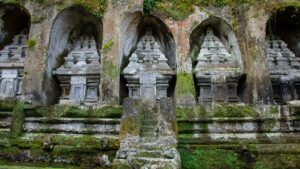
 Tenganan Village Bali: An Insider’s Guide to Ancient Culture and Traditions
Tenganan Village Bali: An Insider’s Guide to Ancient Culture and Traditions
We'd love to hear from you! Share your thoughts or experiences in the comments below!